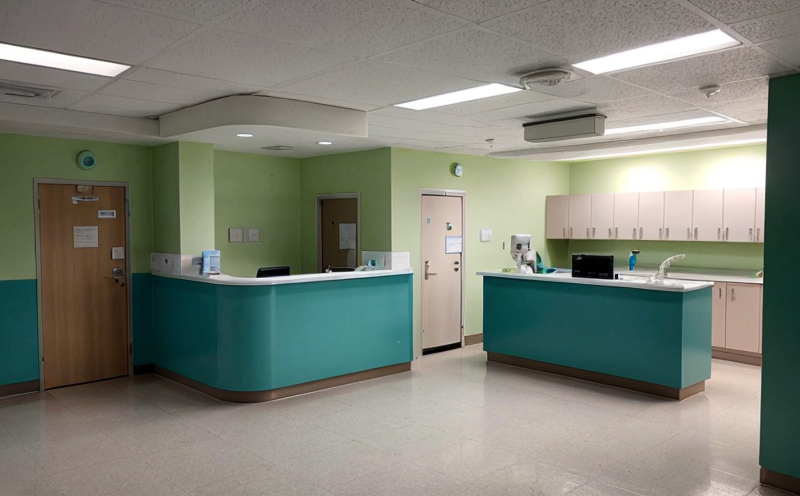ISO 11737-1 Bioburden Testing in Medical Environments
The ISO 11737 series of standards is a critical set for medical device manufacturers, especially those involved with hospital and healthcare environments. The first part, ISO 11737-1:2019, focuses specifically on bioburden testing, which measures the number of viable microorganisms present in or on a material, product, or surface before sterilization or disinfection.
Bioburden is one of the most crucial parameters affecting the microbial contamination level after processing. It plays a significant role in determining the efficacy of sterilization and disinfection processes used in healthcare facilities. This testing ensures that medical devices are safe for use by minimizing potential risks from microorganisms such as bacteria, fungi, or other pathogens.
Medical environments present unique challenges due to the high microbial load often found on surfaces, instruments, and equipment. The bioburden test helps prevent contamination of sterile products and healthcare-associated infections (HAIs). HAIs are a major concern in hospitals worldwide, and reducing their incidence is paramount to patient safety.
The ISO 11737-1 standard provides detailed methods for sampling and testing bioburden. It outlines the steps necessary to ensure accurate results, including proper specimen collection techniques, appropriate culture media, incubation conditions, and interpretation of growth data. Compliance with this standard is essential for manufacturers seeking regulatory approval or certification.
The test involves several key components:
- Sampling: Selecting representative samples from various parts of the medical device or surface to be tested.
- Culture Media: Using specific media that can support microbial growth relevant to healthcare environments.
- Inoculation: Applying the collected sample onto the culture medium in a controlled manner.
- Incubation: Maintaining optimal temperature and humidity levels for microbial proliferation.
- Counting Colonies: Carefully counting visible colonies after incubation, which indicates the presence of viable microorganisms.
The results from this testing provide valuable information about the initial microbial load present on a medical device or surface. This data is crucial for evaluating the effectiveness of subsequent sterilization processes and ensuring compliance with industry standards.
Understanding bioburden is essential because it directly impacts product safety and efficacy, especially in high-risk areas like hospitals where even minimal contamination can lead to severe health issues. By adhering to ISO 11737-1 guidelines, manufacturers can ensure their products meet stringent quality requirements set forth by regulatory bodies.
In summary, bioburden testing is an integral part of the manufacturing process for medical devices used in hospitals and healthcare settings. It ensures that these products are free from excessive microbial contamination before being sterilized or disinfected. This not only enhances product safety but also helps reduce the risk of HAIs, contributing significantly to better patient outcomes.
Quality and Reliability Assurance
The quality and reliability assurance (QA/QC) processes associated with ISO 11737-1 bioburden testing are critical for ensuring consistent, accurate results. QA involves establishing procedures to monitor and control the factors that influence test outcomes, while QC focuses on actual performance checks during each testing cycle.
- Sampling Procedures: Rigorous sampling protocols ensure that representative samples are collected from all relevant areas of a medical device or surface. This minimizes bias and ensures accurate bioburden assessments.
- Culture Media Selection: Using appropriate culture media is crucial for detecting various types of microorganisms present in the sample. Different pathogens may require specialized media to grow optimally.
- Inoculation Techniques: Precise inoculation methods are vital for distributing the collected sample evenly across the culture medium, which ensures consistent microbial growth patterns.
- Incubation Conditions: Maintaining strict temperature and humidity controls during incubation periods guarantees optimal conditions for microbial proliferation without altering test results.
Regular calibration of equipment used in bioburden testing is essential to maintain accuracy throughout the entire process. This includes regular checks on incubators, laminar flow hoods, and any other devices involved in sample preparation or analysis.
In addition to these technical aspects, documentation plays a vital role in QA/QC for ISO 11737-1 compliance. Detailed records of all sampling events, inoculation procedures, incubation times, and colony counts provide transparent evidence supporting the validity of test results.
By implementing robust QA/QC measures, laboratories can demonstrate their commitment to delivering reliable bioburden data that meet both internal standards and external regulatory requirements. This enhances trust among stakeholders, including healthcare providers who rely on these tests for informed decision-making regarding product safety and efficacy.
International Acceptance and Recognition
The ISO 11737 series of standards has gained widespread acceptance across the globe, particularly in industries dealing with medical devices and healthcare environments. Countries such as the United States, Europe, Canada, Australia, and many others recognize these standards as authoritative guidelines for bioburden testing.
- The ISO 11737-1 standard was developed through collaboration between experts from various countries, ensuring its relevance and applicability worldwide.
- Many regulatory bodies around the world incorporate references to ISO standards into their requirements for medical device approvals. For instance, the U.S. Food and Drug Administration (FDA) and European Medical Device Directive (MDD) often mandate compliance with these specifications when evaluating new products.
- The World Health Organization (WHO) also recommends adherence to ISO 11737-1 standards as part of its global efforts towards improving patient safety in healthcare facilities. Compliance enhances international trade opportunities by facilitating mutual recognition between different markets.
Compliance with ISO 11737-1 is not only beneficial for gaining market access but also helps maintain a competitive edge in the industry. It demonstrates a company's dedication to producing high-quality, safe products that meet stringent international standards.
Environmental and Sustainability Contributions
Bioburden testing aligns well with broader sustainability goals within healthcare facilities. By ensuring proper bioburden levels on medical devices, hospitals can reduce the incidence of HAIs, leading to shorter patient stays and lower overall costs associated with treating infections.
Additionally, reducing contamination through effective bioburden testing supports environmental conservation efforts by minimizing waste generation from unnecessary treatments or extended hospitalizations due to infections. This contributes positively towards achieving sustainable healthcare practices.
Manufacturers adhering to ISO 11737-1 also benefit indirectly by contributing to global sustainability initiatives aimed at reducing healthcare-associated risks and promoting healthier environments for patients, visitors, and staff alike.





